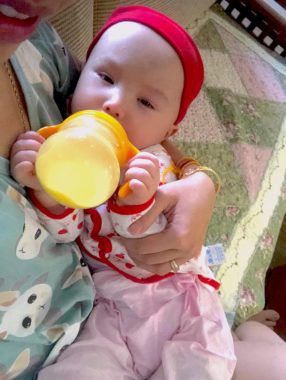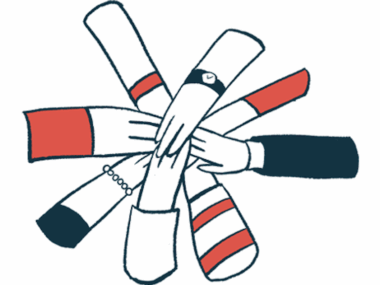Supporting Weight Gain in AADC-deficient Children
Written by |

Our attempts to feed our daughter, Rylae-Ann, who has aromatic l-amino acid decarboxylase (AADC) deficiency, were never a leisurely process. She fussed and spat out food while we endeavored to feed her. Understandably, it was a difficult task for her to complete.
We tried our best not to turn each feeding into a battle, but our daughter was at an unhealthy weight. My wife and I didn’t want to give up, but at the same time, we worried she would aspirate while feeding.
Our attempt to avoid feeding tubes
First, the most critical factor is making sure your child is well nourished and getting plenty of fluids. If this means that a doctor recommends using a feeding tube or port, go for it. Feeding tubes can be a temporary solution while you work on improving feeding, while a port is a more long-term solution.
We avoided feeding tubes and ports because we used feeding times to work on speech therapy. Feeding helps develop the muscles that will be essential for speech. If we could get her weight up, we could continue working on speech.

When Rylae-Ann was admitted to the hospital, she required a feeding tube. (Photo by Richard E. Poulin III)
Feeding is a challenge
We must be vigilant during feeding and understand that it’s a challenge for AADC-deficient children. My wife and I worked as a team and would meet each other’s eyes and give a nod of determination or cheer of encouragement before commencing. Due to their symptoms of weak muscles and autonomic dysfunction, AADC-deficient children don’t have the same innate abilities to swallow or keep down food easily. Parents and caregivers will need to step in daily to ensure success.

Eventually, Rylae-Ann was able to go from a liquid diet to a pureed diet, but she still had a milk formula supplement twice a day. (Photo by Richard E. Poulin III)
Weight loss
Despite our efforts and progress, our daughter was losing weight. She was admitted to the hospital for aspiration, lung infection, and pneumonia within her first year of life. Our doctor thought the time had come to switch to a port. However, we made progress and learned more about preventing aspiration, so we wanted to observe for another two weeks.
The doctor agreed that it would be safe. If Rylae-Ann’s weight didn’t increase, she would get a feeding port at the next appointment. Before we left, we asked the doctor what food would offer the most significant weight gain. At the time, our 1-year-old daughter was on a liquid diet of milk formula. Immediately, the doctor recommended a brand that was readily available to us in Singapore. We set off to the store to pick up a large tin.

In addition to adding milk formula supplement to Rylae-Ann’s diet, we had to make sure she kept her food down to prevent aspiration and to allow for weight gain. (Photo by Richard E. Poulin III)
Gaining weight
Using the doctor-recommended formula, our daughter began gaining weight, even though our team still had to persist in honing our feeding skills.
Baby milk formula is a liquid nutrition supplement. There are different brands and varieties, so you must read the nutrition label even when comparing products from the same manufacturer. Also, don’t judge a book by the cover. Even if a label looks shiny and professional, inspect it and research the manufacturer. If the label notes an age group, this doesn’t necessarily apply to our children. Children with medical conditions have different needs. For us, we looked closely at the number of calories per serving.
After looking at calories, we would select the version that offered the greatest amounts of protein, fat, and fiber. Every brand provided all the necessary vitamins and minerals; however, it was a plus to find one fortified with omega-3 fatty acids. The amount of sugar was not a deal-breaker for us; it probably made feeding easier. However, if you prefer lower sugar content, first look at the calories and then compromise on the version that offers the lowest sugar.
There is even a specialty formula for children with a feeding tube. This can help your child gain the necessary weight so you can go back to working on oral feeding.

As Rylae-Ann drinks her milk formula supplement, her mother may place her hands on the bottle to help Rylae-Ann get used to the feeling. (Photo by Richard E. Poulin III)
Steady and systematic progress
Feeding is a perpetual process that requires patience and practice for you and your child. You don’t need to rush, and you don’t want to skip a step. Involve your primary care physicians so they can monitor this process. They will provide recommendations or alert you when you need to modify your course.
After improving the feeding process using an enriched milk formula, we were able to better manage our daughter’s diet. This led to more progress and her ability to eat pureed solid foods before gene therapy.
Today, after gene therapy, she can eat solid foods independently and speaks in short sentences. The progress continues, but none of this would have been possible if we didn’t take those small steps in the beginning and maintain our perseverance to help our daughter reach her goals.

Today, Rylae-Ann is able to independently feed herself a well-balanced and nutritious meal. (Photo by Richard E. Poulin III)
Note: AADC News is strictly a news and information website about the disease. It does not provide medical advice, diagnosis, or treatment. This content is not intended to be a substitute for professional medical advice, diagnosis, or treatment. Always seek the advice of your physician or other qualified health provider with any questions you may have regarding a medical condition. Never disregard professional medical advice or delay in seeking it because of something you have read on this website. The opinions expressed in this column are not those of AADC News or its parent company, Bionews, and are intended to spark discussion about issues pertaining to aromatic l-amino acid decarboxylase deficiency.






Leave a comment
Fill in the required fields to post. Your email address will not be published.